
FLORIDA
IN THE 1920'S
THE GREAT FLORIDA
LAND BOOM
THE MONEY MIGRATION
In the 1920's Florida was the focus of one of the greatest economic and
social phenomenon in American history as hundreds of thousands of Americans of
all types of financial strata poured into the Sunshine State and forever changed the global image of Florida.
There were similar movements in the south of France
during the 1920's, but the Florida
story was so vast and complete that it changed the entire scope of the state. After the 1920's Florida would never again be viewed as an farming state.
Two
important elements played roles in the Florida Land
Boom. For the first time Americans had the time and money to travel to Florida to invest in
real estate. For the educated and skilled working American, the 1920's meant
paid vacations, pensions, and fringe benefits unheard of during the Victorian
Era. The United States also
had the automobile: that indispensable family transportation that allowed you
to travel to Florida.
This "welfare capitalism" of time and money contributed to the
arrival in Florida
of a new kind of tourist - middle class families.
It was
also important that millions of Americans were captured by the materialism and
prosperity of the times, which seemed to indicate that anyone could become rich
by simply investing in the proper instrument of instant wealth. Florida land appeared to
be in 1921 one of those instruments of future success. It didn't matter if you
lacked the money, credit was easy to obtain, with
economic prosperity and a good job.


These
sudden winter migrations of vacationers and speculators had an enormous impact
upon every aspect of public investment in Florida. Prior to 1920, the majority of Florida's Northern
arrivals were the elderly, the rich, and the ill, not necessarily in that
order. The Florida Land
Boom brought middle aged, middle class Americans, many with their
families. The railroad hotels like the Tampa Bay Hotel, with its triple digit
fares, was hardly the ideal vacation sport for this new tourist.
A COOPERATIVE GOVERNMENT
Just as the Republican administration of Warren G. Harding promoted
lower taxes and greater business prosperity at the national level, the
conservative state governments of Florida in the 1920's acknowledged the need
to improve the state's transportation and public services to accommodate this
boom of visitors. The State of Florida
and many cities borrowed considerable amounts of money at high interest rates
to build facilities to attract the expected growth of new residents and
tourists.
Northern
newsmen glamorized the early
Florida Land Boom in Florida with stories how land investors had
doubled their profits within months. Real estate firms soon realized that it
was more profitable to sell land by auction than to set a listed price. As land
prices rose, the desire for profit rose.


While not
all land speculating met with success, most investors in the beginning stages
of the Florida Land Boom made a profit selling the land
to others. An elderly man in Pinellas
County was committed to a
sanitarium by his sons for spending his life savings of $1,700 on a piece of
Pinellas property. When the value of the land reached $300,000 in 1925, the
man's lawyer got him released to sue his children. In the 1920's in Florida the difference
between genius and idiot was never so narrow.
BINDER BOYS AND REAL ESTATE
The need for real estate salespersons was so great at the height of the
boom that Florida
relaxed its regulation of realtors. It didn't really matter since two-thirds of
all Florida real estate was sold by mail to
speculators who never visited Florida.
Those who came were gripped by the frenzy of land buying. In 1922 the Miami
Herald was the heaviest newspaper in the nation due to its massive land
advertisement sections.


 The strangest element of the Florida real estate
industry was the use of binder boys
to start land transactions and to relieve realtors of the task of standing
around hot, vacant land waiting for investors. Most binder boys were young,
ambitious men and women willing to take a binder, or down payment with a thirty
day financing period. Many binder boys were college students with tennis or
golf skills who demonstrated the desirability of some future real estate
development by just playing a game of tennis for the tourists. Often there was
little more than a fancy entrance way and a tennis court resting in some
isolated field.
The strangest element of the Florida real estate
industry was the use of binder boys
to start land transactions and to relieve realtors of the task of standing
around hot, vacant land waiting for investors. Most binder boys were young,
ambitious men and women willing to take a binder, or down payment with a thirty
day financing period. Many binder boys were college students with tennis or
golf skills who demonstrated the desirability of some future real estate
development by just playing a game of tennis for the tourists. Often there was
little more than a fancy entrance way and a tennis court resting in some
isolated field.
Binder
boys did not get paid a commission until the binder check cleared the bank, a
process that sometimes took several weeks. However, South
Florida lived real estate during this time and binders discovered
the mere presentation of their binder receipts gave them instant credit in
hotels, restaurants, and nightspots. It was exciting being a young person with
so much expected money going into your bank account.
FLORIDA
POLITICS IN THE BOOM
 Florida voters liked the business
prosperity and elected business supporter John Martin, thrice mayor of Jacksonville, to serve as Governor
on a platform of expansive construction and development. The Florida
Legislature in 1924 passed laws prohibiting state income and inheritance taxes,
moves designed to convince wealthy visitors to make Florida their permanent residence. The rural
politicians were even willing to concede economic power to big cities like Miami and St.
Petersburg to promote tourist development.
Florida voters liked the business
prosperity and elected business supporter John Martin, thrice mayor of Jacksonville, to serve as Governor
on a platform of expansive construction and development. The Florida
Legislature in 1924 passed laws prohibiting state income and inheritance taxes,
moves designed to convince wealthy visitors to make Florida their permanent residence. The rural
politicians were even willing to concede economic power to big cities like Miami and St.
Petersburg to promote tourist development.
The Florida Chamber of Commerce contributed to the Land Boom
with favorable newspaper articles of the virtues of Florida land investment. They invited every
Governor in the nation to view the state and sixteen Governors came and gasped
in amazement as outgoing Governor Cary
A. Hardee, a small towner, cut the ribbon
opening Gandy Bridge, the longest toll bridge in the
world. Later Hardee would be amazed at the plans of developer George Merrick to construct the
massive Biltmore Hotel in Coral Gables.
Things were getting done on a huge scale in Florida.
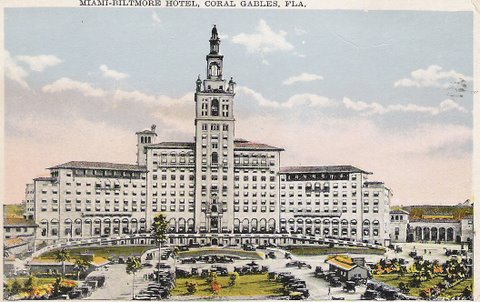
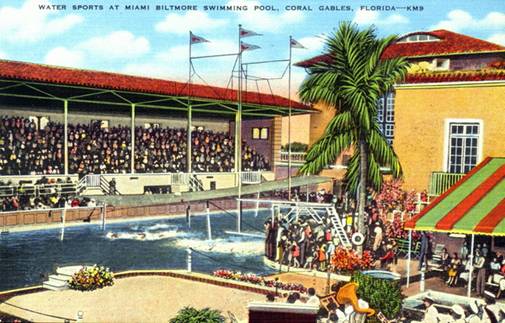
THE LAND DEVELOPERS -- KINGS OF THE 1920'S
If the railroad barons dominated the Gilded Era, the great land
developers dominated the Florida
of the Land Boom. These people didn't just design developments; some created
entire cities. These architects and engineers did more than build houses; they
created a way of life that became known throughout the world as "the Florida lifestyle."
The
architectural style tended to be
Mediterranean Revival since Florida was
the replacement for Southern California and the European Riviera, but every conceivable variation of
design was developed. Designers took advantage of Florida's warm climate and outdoor ways.
Dave Davis, the son of a steamboat captain, dredged two mud islands at the
entrance of Tampa's Hillsborough River and developed Davis Islands, a
distinctive urban suburb complete with hotels, yacht and tennis clubs, and
stores.
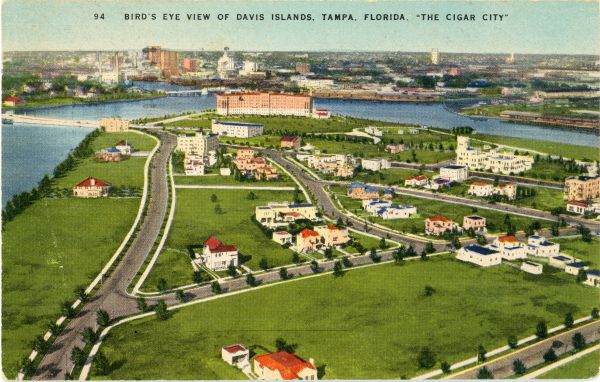

Besides
Davis, the Tampa Bay area included a diversity of new 1920's developments: Temple Terrace, one of the first
golfing vacation communities; Snell Island, St. Petersburg's answer to Davis
Islands; and Beach Park, a residential community made possible by good urban
commuting.
Further
down the Florida West Coast, an railroad union designed one of the first retirement
communities in Venice, and Barron Collier started Naples and Marco
Island as winter resorts.
BARRON COLLIER
The most
spectacular developments were in Southeast Florida where Henry Flagler's
railroad caused direct access to New
York City. Carl
Fisher, the man who started the Indianapolis Speedway, teamed with
developer John Collins to build
a causeway to a mangrove island off Miami.
They turned Miami Beach into the world's most
famous resort address by 1950. George
Merrick, the man who designed the suburb of Coral Gables.
Buying
1,100 acres of citrus, Marrick created an entire
working city that typified his vision for Florida. Strict rules limited the
architectural design and height of every building. He hide
wires beneath of streets.

Lacking a
waterfront, Merrick designed Venetian Pool, the largest swimming
pool in the nation. He hired William Jennings Bryan to give Biblical
lessons to the Midwestern farmers and recruited major sports celebrities to
work out in his outdoor facilities. Merrick even started the
one thing booming Miami couldn't get from Tallahassee -- a college, when Merrick
started the largest private university in the South, the University
of Miami.
A
Californian named Joseph W. Young
selected an ugly ocean flat north of Miami and turned it into wide avenued Hollywood,
Florida, larger today than Young's original home town. Less successful
but more praised for his activities was architect Addison Mizner. He designed the Boca Raton Hotel (Cloister Hotel) and
the town that soon surrounded it.
These were
just some of the developers who made the name Florida synonymous with palm trees and
beaches, wide avenues and golf courses. Southernmost Florida
became surnamed the American Riviera. Writers
from around the world made a pilgrimage to this fascinating new Mecca. Florida was a place
to vacation, a place to have fun, a place to make money.
EVENTS AND WARNINGS
There was plenty of
evidence that the Florida
Land Boom was on swampy
ground. Forbes magazine warned that Florida land prices were based solely upon
the expectation of finding a customer, not upon any reality of land value. New
York bankers, losing money over Florida investment, attacked the entire
operation as one great sham. By 1925, there were other signs. Companies were laying off construction and other blue collar workers while
the number of realtors and auto mechanics was still increasing.

Jacksonville, the state's main entrance way, outgrew
its facilities, but became leery of financing services for people heading
further southward. On the surface, the Land Boom seemed on track. In 1924
enough lumber arrived in Florida
to encircle the equator with an eight foot boardwalk. But careful city managers
were wondering if their town's had overextended their
credit to construct roads and sewers for people who would never settle in their
towns.
THE TIN CANNERS
Florida tourist had forever changed, and few
groups had a greater influence on this fact than "the tin can
tourists." They were tourist who arrived by automobile and truck, loaded
with tents and food supplies. Sometimes as many as three families shared an automobile.
While they too hoped to buy some Florida real
estate, their trip to Florida
was a vacation. They could not afford the fancy hotels and restaurants built
for the Victorian tourist. They didn't golf and tennis. They wanted to play in
the sunshine on the beaches.
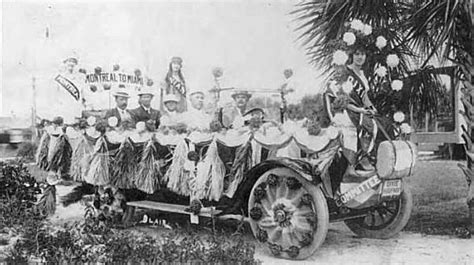
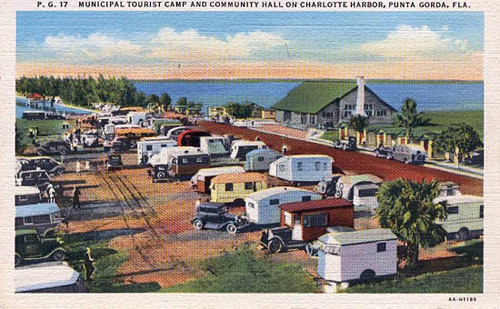
As early
as 1919 Tampa
had a "tin-canners" club,
named for the heavy metal cans which these tourists carried for extra gasoline
and water. As the automobile grew in popularity, these "T.C.T.s" became more important to local tourist economies.
Towns began to build tourist camps with recreational facilities. Owners along
the major highways built small cabins for these tourists. Soon, the development
of the mobile home industry would replace most of the tents.
The influx
of motorized tourism convinced Florida's
leaders that new roads were needed. The most amazing highway project was the
development of a highway across the once impregnable Everglades.
In 1915, realtor Captain J. F. Jaudon gained financing for a Miami
to Naples
roadway. Surveyors discovered that the "River of Grass"
was no deeper than six feet, but the project, known as the Tamiami Trail
for the two major cities the project would connect.

Construction
crews began to erect gangways of cypress logs to roll the heavy dredges over
the swamps. Engineers waded through alligator-infested waters to locate the
best roadbed. Sleeping in elevated cabins kept out the snakes and gators, but
did not protect the workers from the terrible heat and bugs. The Seminoles were
both amused and angered by this intrusion into their home despite promises that
canoe trails would be bridged.
In 1923
the project was delayed due to lack of funding and Fort
Myers crusader Ora E. Chapin led a
caravan of Model-T Fords, tractors, and wagons across the incomplete roadway.
It took ten, laborious days, but these
"Tamiami Trail Blazers" convinced
the public that the project was both feasible and desirable. In April of 1928,
thirteen years after its inception, the 283 mile road was completed. It cost
seven million dollars, a meager sum by today's costs. It meant that South Florida's two tropical coasts were connected.
PROHIBITION DAYS
While rural Floridians accepted the outlawing of alcoholic beverages,
urban Floridians actively disliked Prohibition. Unlike other Southern states, Florida had serious Prohibition problems due to both its
close proximity to the Bahamas
and Cuba,
and its general environment as a vacation group for Northerners and foreigners.
Nassau and Grand
Bahama flourished as rum smuggling centers and Florida's one thousand
mile coastline was hardly conducive to stop the smuggling of hootch. Despite the fact that locals were just a boat trip away from a wet vacation, Florida's tourist industry didn't want
tourists taking their money to another country. In 1921, there were nine
enormous liquor warehouses on Grand Bahama Island,
just sixty miles from Palm Beach.
This was the start of Rum Run to
Florida.
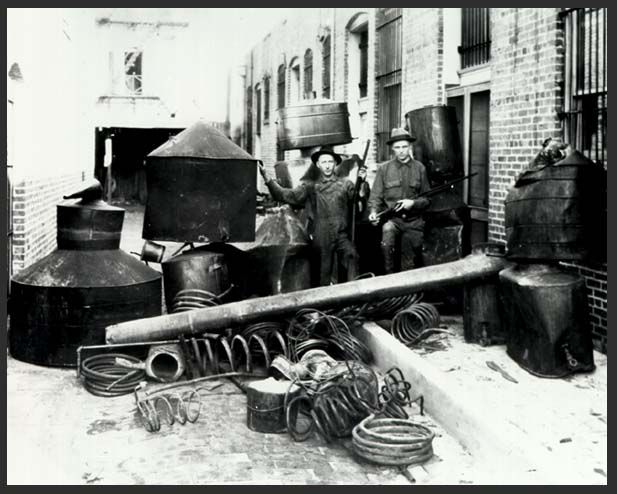

There were
more registered crop dusters and more new airplane runways in Florida in the 1920's than any other
Southern state. Indignant Florida leaders
assailed the laxity of controls in the Bahamas,
but the only concession England
made was to allow the United States
to search British vessels in Florida
waters.
The
smugglers developed"Bimini boats", large cargo speedboats
with equipment designed to detect Coast Guard vessels. Besides their speed and
shallow draft many of these boats contained devices to ditch a cargo into the Florida Strait. In 1927, the Coast Guard introduced a
thirteen million armada of new, faster ships, and much of the smuggling was
curtailed.
Still,
some areas of Florida
were havens for violations. Tampa, with its large Latin population, Miami, and Palm Beach were filled
with speakeasies and gambling. It did not help Florida's
image that Al Capone, the
kingpin of organized crime, selected Miami
as his winter home. Al decided Miami would be an
"open crime city" so he wasn't blamed for every criminal offense in Dade County.
THE MUCK BOWL
The influx of people promoted an increase in farming, particularly of
large scale agriculture along Lake Okeechobee,
often called "the Muck Bowl"
for its marshy terrain. In the 1920's canals and dikes were built across the
region, diverting much needed water from the Everglades.
This development did not benefit Florida's
Panhandle farmers, suffering from rising inflation and low farm prices. Most of
these new farms grew winter fruits and vegetables and utilized a large
migratory population.
Despite
the general prosperity of the 1920's for middle class Americans, the rapid
social and economic changes of the decade helped foster rising racism and nativism. The anti-immigration movement and fear of the
loss of earlier institutions were factors in the rise of the Klu Klux Klan in Florida
in the 1920's. Individual racial incidents led to serious acts of violence in
Perry (1922), Rosewood (1923) and Oconee (Florida), when white mobs attacked
African-Americans and burnt residences.


The Florida migrant included workers from both the Deep South
and Caribbean. Working for nine to fifteen
dollars per week in the tropical sun, they lived in crude company towns, often
just miles from the glamour of the coastal resorts.

Many
migrant areas lacked schools and health facilities. They usually did not lack a
"jook
joint." Jooks were usually the only
recreational recluse for the migrant worker: a small tavern and frontier dance
hall, where music poured out of a coin-operated magazine phonograph. It was
ironic to drive through the silent blackness of South Florida
to discover a noisy, neon snack, blaring away music that at least temporarily
lessened the agony of daily life.
The small
farmers of Florida did not benefit from the Florida Land Boom. Neither did most towns in North Florida unless they were on a major highway. The
departure of many young Floridians into the urban work force also crippled Florida's small towns.
The life style and diet of rural Florida
in 1928 was not greatly changed from 1898.
THE GREAT FLORIDA
LAND BUST
In 1925, the inevitable began to occur in the real estate industry.
Land prices had reached such a zenith that new customers failed to arrive and
old customers began to sell their land. Suddenly, the only market for Florida land was for
selling land.

The larger
cities of Florida
felt the impact first. They had borrowed heavily to finance new road and public
service construction and utilized sales taxes and land fees to pay their debts.
Now the Yankee dollars were vanishing. St. Petersburg
was the most indebted per citizen town in the United States. Key West ranked second.
Caught
without customers, many realtors folded up business, sending their binder boys
home. One clever Pinellas realtor found a way to send his binders back up North
without personal cost. He contracted with a funeral company that by law had to
escort the bodies of deceased retirees to Northern cemeteries. Instead of
funeral employees, the realtor and funeral director cashed in the two-way
tickets for one-way tickets and placed binder boys on the trains as escorts.
The news of the Florida
Land Bust crippled the
tourist market. There was a bad hurricane in 1926 that destroyed many Miami developments. Despite the continued boom in the United
States Stock Market, people no longer trusted buying Florida land. And yet,
the land was merely overpriced.
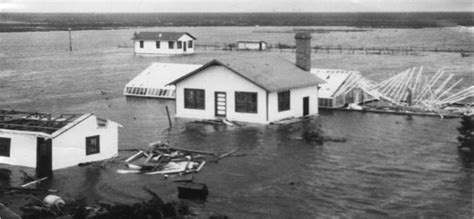
As if the
land collapse was not bad enough, a terrible hurricane hit South
Florida in September of 1928 with winds in excess of 125 miles per
hour. Traveling parallel to the Atlantic Ocean, the storm suddenly turned west
across Palm Beach
County into the heartland
of the muck lands.
The migrant workers and small farmers of Lake Okeechobee
were asleep. Few had radios. They had no automobiles for a quick escape. As the
winds of the hurricane moved counterclockwise across the lake, the south end of
the lake was dried up. When the storm passed by, however, a huge tidal wave
crashed down of the people of Belle Glade and Moore Haven.
The
hurricane was an unwelcome coup de grace to the Florida Land Bust. Over 13,000 homes were
destroyed. 115 were dead in Miami
and the tidal wave had drowned 300 people. The news of people drowning in a
wave, thirty miles from the Atlantic Ocean
amazed people across the world. The nameless migrants were piled up and burnt
to prevent plague. The major developments were in ruins, many of them unable to
recover.
It would
take years to rebuild the confidence and spirit of the Florida Land
Boom. When the Great Depression hit Florida,
it had a limited impact since so many Floridians were already in weak financial
state. A year later the arrival of the
Mediterranean fruit fly would hurt the citrus industry. Certainly, many
Floridians wondered if Florida would ever see
again such wonderful and confident times as the Florida Land
Boom.







![]() The strangest element of the
The strangest element of the  Florida voters liked the business
prosperity and elected business supporter John Martin, thrice mayor of Jacksonville, to serve as Governor
on a platform of expansive construction and development. The
Florida voters liked the business
prosperity and elected business supporter John Martin, thrice mayor of Jacksonville, to serve as Governor
on a platform of expansive construction and development. The 




![]()


![]()





![]()
